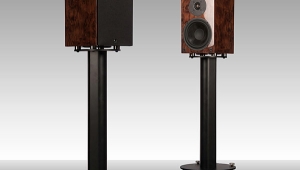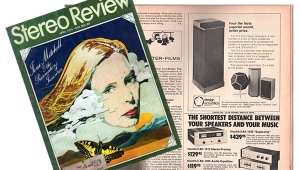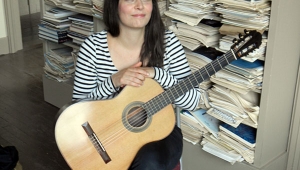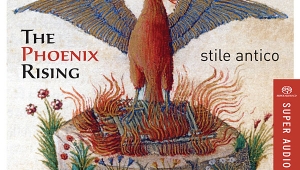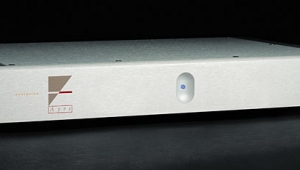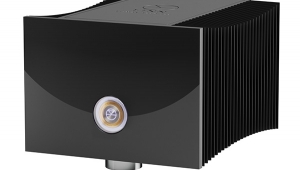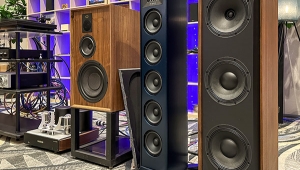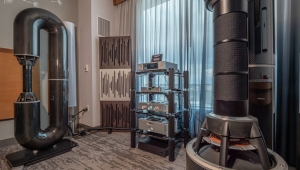| Columns Retired Columns & Blogs |
The Fifth Element #38 Page 2
While recording, pressing Record again starts a new .wav file. There is a brief pause as a new file is created and named, but again, no audio is lost, thanks to the buffering-and-cache arrangement. From Stop, pressing Play replays the last audio track recorded.
In short, Sound Devices has put lots of thought and lots of practical experience into the Model 722. It's not quite foolproof, but it's clear they've been looking out for the end-user.
The owner's manual and the LCD screen's menu structure, if they did not quite fill me with trepidation, at least made me acutely aware that I had started off doing editing with a razor blade. But then I just said, "Hey, let's use this as backup—how bad can it be?" A few successful takes later, I was grinning. The 722 is built like a tank, by the way: Sound Devices' print catalog shows people catching audio from Mount Everest to the Syrian Desert.
It is one measure of the functionality packed into the 722 that its main menu has 78 subscreens. Given that the 722 is essentially a computer customized for audio, nearly everything you could possibly want is variable, adjustable, or defeatable: the LCD screen's contrast, illumination, and brightness are all adjustable; there are a tone generator and optional warning chimes; the recording-level LCD meters' "ballistics" are selectable; and on and on. The combination of LCD screen plus a raft of LED status lights makes things very intelligible, once you've spent the necessary time on the learning curve.
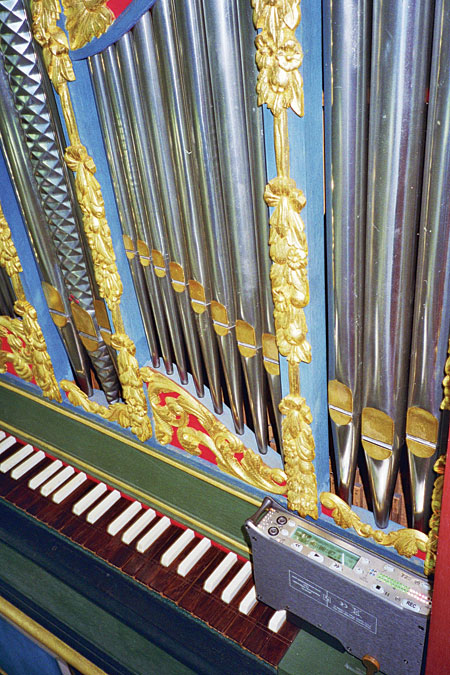
Sound Devices also makes a four-channel model, the 744, which has two XLR/mike-preamp inputs and two line inputs. That is both for real-estate and practicality issues. You can record two main stereo tracks, mix as many as four other mikes on a Sound Devices companion mixer, and route them to the other tracks at line level. For short-run ENG, Sound Devices makes non–hard-disk, CF-only recorders, and, for film and television use, time-code–enabled recorders.
Sound Devices' website is well worth a visit. Just stop drooling! I particularly recommend their demo of 24-bit vs 16-bit recording. Even in MP3, I think the case is made. Sound Devices is, as you will see, agnostic about mike cables. Their pitch for 24-bit recording is from a practical standpoint: using all the headroom, and thereby risking nasty digital "overs," is a lot less critical when you have 24 bits to play with instead of 16.
I first laid hands on a Sound Devices 7-series recorder at a small dinner party given by Peter McGrath, of Wilson Audio Specialties, which coincided with Home Entertainment 2005. Jerry Bruck had brought a 7-series recorder along for all of us to ooh and aah over. (But there's nothing like recording with one.) John Atkinson was in attendance, and I think it fair to say that he was gobsmacked to hear Bruck's reminiscences of Gustav Mahler's widow, Alma, seeing as Mahler himself died in 1911. (Bruck is a dealer in professional sound-recording equipment and a Sound Devices distributor. He brings a wealth of practical experience to the transaction.)
I don't know how realistic the prospect of buying a 722 is for someone who doesn't make live recordings but who does want to listen to music on the go at higher-than-CD resolution, but seeing as a 722 costs less than some pairs of interconnects I could mention, I quote Carlos Mencia: De-de-dee!
Around and about
I used the Sound Devices 722 to record some M-S stereo matrix demo tracks courtesy of blues guitarist extraordinaire Thom Enright. Enright, an alumnus of both Roomful of Blues and the John Cafferty Beaver Brown Band (of Eddie and the Cruisers fame), came to my living-listening-demo-recording room and noodled for a while. He, too, was stricken by lust for the 722. My August column explains the M-S technique and an M-S demo track can be found here.
A bonus, unplugged version of Enright's own song "Watch You When You Go," can be found here.
Continuing our slow-motion pilgrimage among the historical and significant pipe organs of Rhode Island for the RI chapter of the American Guild of Organists, I stopped in at the Old Narragansett Church, which houses what is reputed to be the oldest pipe organ in North America that is still in regularly scheduled use for worship. The organ has been authoritatively identified as the ca-1680 work of the legendary German-English organ builder Bernard "Father" Smith (né Schmidt), who built the first organ at the then-new St. Paul's in London. Smith was organ maker to Charles II, and a friend and colleague of both John Blow and Henry Purcell.
Recent scholarship suggests that the Old Narragansett Church organ contains wooden bass pipes that date back to about 1640, and which came from an organ damaged in the Great Fire of London of 1666. Those pipes, the experts say, were salvaged and re-used, and still show signs of smoke damage. To record a musical instrument that predates all of J.S. Bach's known output is quite a thing, I assure you. Mark Steinbach played two short pieces by a 19th-century Rhode Island composer.
I wish I could tell you that it was the Music of the Spheres. It sounded like a wooden box full of old bicycle parts being thrown down the stairs, with a reed organ in the background. By which I mean, the treadle-action bellows pump was pretty noisy. The Old Narragansett Church has no electricity, and never has. It was built elsewhere in 1707, and decades later was disassembled, then reassembled at its present site on Church Lane in Wickford, Rhode Island. There isn't room enough inside to swing a cat.
I used to spend a few weeks in Wickford every summer when I was a boy, as my aunt and uncle lived at 25 Main Street, about three blocks away from Old Narragansett Church. Wickford was not then the chichi destination for New Yorkers it is now, but a down-at-heels seaside village with a spillover of Navy housing from Quonset. (The local quip about such a place is "A quaint drinking village with a small fishing problem.")
My brothers and cousins and I used to set out minnow traps and sell the poor creatures as fishing bait for 35¢ a quart, then go to the movies. I don't think I'd have the heart to do it now. Indeed, once I'd put a few minnows in a large goldfish bowl and spent hours marveling at their sleek and subtly colored beauty, I was less eager to turn them into cash.
We also visited the Christian Science Church in Providence, where Peter Krasinski plays a 1912 Hutchings-Votey organ. That instrument sounded as lush as velvet, with a decidedly dark tonal luster. Just to prove that one size does not fit all, the same mike setup that served well at the First Baptist Church (August, p.41) did not work out as well at the Christian Science Church, although it seemed okay on headphones. The bass was just too prominent, so some judicious EQ or a re-record is in order. (That was a situation where having the four-track Sound Devices 744 might have paid off: dual figure-8 M-S on two tracks, spaced omnis on the other two.) Peter played M. Searle Wright's Lyric Rhapsody, a little-known American masterpiece.
Peter also humored me by playing two thrilling improvisations on Parry's setting of Blake's poem "Jerusalem," which, if it does not figure in your worship tradition, you may remember from the first and last scenes of the film Chariots of Fire. I think it would be a very fine thing if someone would record a dozen contemporary organists on a dozen great organs, each improvising on Parry's "Jerusalem." (Backers or angels: Please e-mail me.) I commented to Peter that I was grateful for his willingness to play "Jerusalem," as I hadn't expected to get anywhere asking for a medley of Procol Harum's greatest hits. To which Peter replied "All of them?" while engineer Steve Dreyfuss pretended to be able to remember only one. Instead, Peter played a couple of measures of "Stairway to Heaven." I'll get around to that someday, too!
Seeing as the 722 was serving as backup to the backup, I experimented by recording some takes of Wright's Lyric Rhapsody at 24/96 and the "Jerusalem" improvisations at 24/192. They are really something.
So, you may feel tempted to ask, now have we immanentized the eschaton? Sorry, still not quite. The Sound Devices 722 is beyond great, no doubt about it. It packs the functionality of a Nagra-D (and more) into a compact unit you can pick up with one hand, uses more convenient and economical media, and costs a tenth as much. Still, for the 2% of us who live in the land of diminishing returns, I felt that the combination of the Grace 201 and the Tascam DV-RA1000 I described in the August issue' "Fifth Element"—but only in DSD mode—edged past the 722 by a nose. There was just a thereness to the DSD tests I've made that the 722 lacked.
Whether this has to do with the Grace, the Tascam, DSD, or some combination of the three, I don't know. I completely understand Sound Devices' not offering DSD equipment. There is the likelihood that the circuitry could not fit within the chassis they now use. More to the point, as I understand the current state of things: Apart from a handful of classical-music producers and recording engineers, there is simply no demand for DSD equipment.
The right book
We are now in a new Golden Age of pipe-organ building, as least as far as organs for major concert halls go. Meyerson Hall in Dallas, Walt Disney Hall in Los Angeles, and Verizon Hall in Philadelphia all have had important organs installed in recent years. It is very unlikely that a new major concert hall would be planned today without provision for a pipe organ, even if the real motivation were more "bragging rights" than music.
There are two major reasons why this should be so. First, more than 100 major orchestral works call for an organ, and by no means are all of them organ concertos. Yes, you can perform Brahms' Ein deutsches Requiem and Elgar's Enigma Variations without an organ, but what you get is not what the composer intended. Second, electronic organs playing through loudspeakers are simply not a substitute. Anyone who has ever heard the Sunrise section of Strauss's Also sprach Zarathustra with a rented and trucked-in electronic organ will assure you of that.
Thirty and forty years ago, things were quite different. The concert-hall organ was at its lowest ebb. Isaac Stern reportedly said that a pipe organ would be installed in Carnegie Hall over his dead body, an assertion that must have had quite a few people thoughtfully murmuring, "The idea has possibilities." The organ in Philharmonic Hall (now Avery Fisher Hall) was removed and sold to California's Crystal Cathedral, perhaps in an effort to minimize the variables in that hall's ongoing series of "we squeeze it here but it bulges there" acoustical remediations. The organ in Cleveland's Severance Hall was, for the love of God, Montresor, walled off. As were others.
How the place of the organ in our musical and communal life went from its exalted status in the early decades of the 20th century, through trying times and riving controversies over how an organ should sound and how it should be played, to the veritable renaissance of the past few decades, is engrossingly told in Craig Whitney's All the Stops: The Glorious Pipe Organ and Its American Masters. Whitney, a New York Times editor who is also an amateur organist, strikes just the right balance. The book is a fascinating cultural history for the general reader, yet has backstories and insights that will intrigue the professional.
On the eve of the 1929 Crash and the ensuing Great Depression, no marble-halled stately mansion would be complete without a real pipe organ to entertain its guests. Even department stores were so caught up in the cultural striving that Wanamaker's, in Philadelphia, built one of the largest organs in this hemisphere. But a triple whammy would soon rearrange the landscape and put most organ builders firmly on the road to extinction.
First, the Crash and Depression dried up public and private sources of cash for luxury spending. Municipalities, wealthy individuals, and churches all had to cut back. Second, talking motion pictures replaced not only movie-house pianists and pianos but also organists and organs. Finally, substantial improvements in microphones, radios, and phonographs meant that people no longer had to leave the house in order to hear something that sounded enough like live music to meet that need in their lives.
The story of the organ through the 20th century and up to today organizes itself in nearly Hegelian terms, the dialectics of which were often concretized in professional and even personal rivalries. From E.M. Skinner's disputes with G. Donald Harrison over voicing, through the rivalry between E. Power Biggs and Virgil Fox for recording and concert market shares, through the Goliath-and-David contest between the American eclectic "organ for all seasons" and the builders of new organs in truer Renaissance and Baroque styles, Whitney crafts a business-history page-turner. Virgil Fox comes off as a main-chancing exploiter of those closest to him, and a first-class jerk in general. C.B. Fisk, whose tracker-action No.45 (1965) I often hear in Westerly, Rhode Island, comes off as a true gentleman on a sacred mission; I wish I'd met him.
On the cover of the hardcover edition is a dim black-and-white photo of the famous Methuen organ; the cover art of the paperback edition is a color photo of the Rosales/Glatter-Götz organ in Los Angeles' Walt Disney Hall, donated by Toyota and looking like a cartoon of an explosion at a lumber yard. Better yet, the publisher's website hosts an MP3 audio mini-documentary narrated by Whitney. Bravo. Most highly recommended!
For information about the Walt Disney Hall organ, see www.rosales.com. For streaming audio of an excellent radio documentary on it, see www.kcrw.com/cgi-bin/ram_wrap.cgi?/ot/ot041231Celebrating_the_Walt. For information about the Verizon Center organ, see www.dobsonorgan.com/html/instruments/op76_philadelphia.html. And for a QuickTime video about it, see www.whyy.org/artsandculture.
Epistles and brickbats. (what's a brickbat, anyway?)
- Log in or register to post comments

